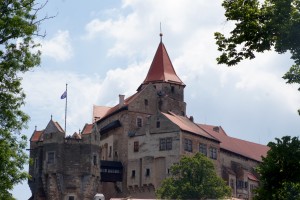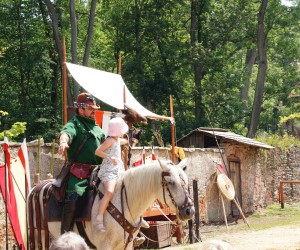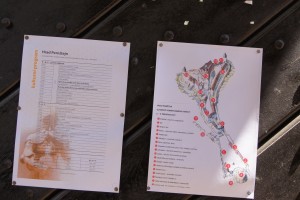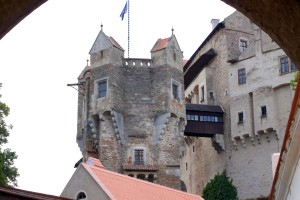Zamek Pernštejn (Czechy) Pernštejn Castle (Czechia)
Rosły mężczyzna w średniowiecznym stroju myśliwskim siedzi na koniu, przemawiając do ludzi zebranych przed nim. Jest on od nich oddzielony belką, biegnącą przez całą długość pokrytego piaskiem pasa gruntu; po stronie gdzie zebrali się gapie rośnie trawa. Kilka metrów od mówcy stoi kobieta w podobnym stroju, na jej ręce – tej, na którą nałożyła skórzaną rękawicę ochronną – siedzi sokół, co jakiś czas dziobiąc grubą skórę. W pewnej chwili „myśliwy” przejeżdża przez całą długość przeznaczonego dla niego pasa ziemi i zwraca się do dziewczynki stojącej w tłumie. Następnie odsuwa się nieco. Malutka (ma może 4-5 lat) nieco nieśmiało przechodzi pod belką i idzie za nim. Chwilę później, podniesiona za wyciągnięte w górę ręce, zostaje posadzona w siodle przed sokolnikiem, a jej prawe przedramię i dłoń zostają wsunięte w rękawicę ochronną, którą wcześniej miał na sobie mężczyzna. Po krótkim wywodzie, który zapewne jest „instrukcją obsługi sokoła” (zapewne – bo o co dokładnie chodzi, wiedzą tylko ludzie znający język czeski), mała wykrzykuje komendę. Ptak szybko unosi się z ramienia kobiety i podlatuje do siedzącej na końskim grzbiecie pary, po czym siada na ramieniu dziewczynki i zaczyna dziobać rękawicę. Kolejny krótki wywód sokolnika, komenda wypowiedziana piskliwym głosem – sokół wzbija się w powietrze i przelatuje na miejsce, z którego zaczął wcześniejszy lot. Dziewczynka zostaje postawiona na ziemi, pożegnana oklaskami podbiega do rodziców. Mężczyzna kieruje konia do miejsca, w którym stał kiedy z nią wcześniej rozmawiał; tym razem wywołuje z publiki chłopca, nieco starszego od poprzedniej uczestniczki pokazu. Młodzieniec dostaje nieco trudniejsze zadanie: po krótkiej „pogadance” wręczono mu sznur, do którego uwiązana była lisia skóra. Kładzie ją na piasku i lekko naciąga sznur. Sokół zostaje posadzony na ręce mężczyzny; na okrzyk sokolnika młody człowiek rusza na przód, jakby od tego jego życie zależało. Ptak gwałtownie zrywa się do lotu i chwilę później opada na „lisa”. W tym momencie „myśliwy” znów się odzywa, chłopiec wypuszcza sznur i odbiega kilka kroków. Przywołany sokół wraca do pana, młody sokolnik znika w tłumie…
Sokolnik, jego uczennica i sokół… Och, i koń! 😉
Mała grupka ludzi (między kilkoma mężczyznami dopatrzyłam się kobiety ubranej w strój wzorowany na męskim) stoi przed widzami; obok nich ustawiono w rzędzie 6 egzemplarzy różnego typu armat. Każda z osób trzyma jakiś rodzaj ręcznej broni palnej. Nieco z boku jeszcze jeden mężczyzna – dokonuje krótkiej prezentacji danego typu broni i za każdym razem zaleca zatkanie uszu: mimo, że w eksponatach nie ma kul (są naładowane tylko prochem strzelniczym), odgłos wystrzału jest przeraźliwie głośny. Gdy już wszyscy zaprezentowali „swoją” broń, przychodzi czas na pokaz wykorzystania armat. I tym razem, jak poprzednie eksponaty, nie są one w pełni ładowane, ale mężczyzna jak mantrę powtarza informację o konieczności zatkania uszu, szczególnie w wypadku dzieci, oraz dodatkową radę: aby otworzyć usta przy wystrzałach.
Nagranie z pokazu użycia armat – część pierwsza…
…oraz część druga.
Kolejna grupka ludzi: 4 mężczyzn i 2 kobiety, w różniących się stylem strojach z epoki średniowiecza; wszyscy trzymają w rękach broń białą. Stojący z boku mężczyzna (nauczyciel?) wydaje komendy w obcym języku, po każdej z nich grupa zwraca się w kierunku wyimaginowanego przeciwnika, padają ciosy. Chwilę później hipotetyczny nauczyciel usuwa się, a pozostałe osoby rozgrywają małe przedstawienie – w dużym skrócie: serię pojedynków jeden na jednego. W jednym z ostatnich pojedynków stopień trudności podwyższa się, przeciwnicy walczą 2 szablami.
Wszystko to jest częścią festynu średniowiecznego, odbywającego się na zamku Pernštejn w Czechach. Mimo, że nie uczestniczyłam w całym wydarzeniu (opisane przeze mnie elementy to jedynie część jednego dnia), byłam oczarowana tym, co zobaczyłam. Najbardziej spodobało mi się to, że kiedy pomiędzy przedstawieniami udałam się do zamku i oglądałam stragany rozstawione obok niego, mogłam zobaczyć ludzi ubranych w średniowieczne stroje – nie tylko „aktorów”, lecz także ludzi z okolicy, którzy postanowili ubrać się w ten sposób, aby wczuć się w klimat epoki. Cały program tegorocznej edycji tego festynu zamieszczam poniżej:
Z zamkiem Pernštejn wiąże się pewna legenda. W czasach, kiedy miejsce to było zamieszkałe, służyła tam pokojówka Eliška (czyli Eliza). Była ona osobą niezwykle próżną, ciągle przeglądała się w lustrze i poprawiała swoją urodę. W końcu doszło do tego, że przestała uczęszczać na nabożeństwa niedzielne w kościele. Dowiedział się o tym mnich z lokalnego klasztoru i przybył na zamek, aby napomnieć „grzeszną niewiastę”. Ona jednak, niepomna na dobre rady zakonnika, odpyskowała mu bezczelnie. Na to zakonnik wściekł się i zagrzmiał wielkim głosem:
– Strzeż się! Spotka cię za to kara piekielna!
Po tych słowach podłoga rozwarła się pod próżną służącą i Eliška zupełnie dosłownie „poszła do diabła”. Od tego czasu pokazuje się czasem w zamku jako Biała Dama. W tym miejscu konieczne jest ostrzeżenie szczególne dla wszelkich urodziwych dam pragnących odwiedzić dawne miejsce służby dziewczyny. Znacie legendę o Krwawej Mary? Tak? Nasza służka w prawdzie nie pokazuje się w lustrach, ale wszelkie zwierciadła na zamku Pernštejn mają od czasu jej śmierci pewną niebezpieczną właściwość. Jaką? Otóż kto się w nich przejrzy, po upływie roku i jednego dnia (to jest, zdaje się, jedno z ulubionych określeń czasu w podobnego rodzaju historiach…) utraci swoją urodę. Nie martwcie się jednak. W niedalekich Boskowicach (o których opowiem wam wszystkim przy innej okazji, w nieco innym kontekście) znajduje się zamek, gdzie umieszczono zwierciadło o przeciwnym działaniu. W razie problemów możecie więc się tam udać…
A grown man in a medieval hunting attire sits on a horse, speaking to the people gathered before him. He is separated from them by a beam running across the length of the strip of soil covered with sand; grass grows on the side where the crowd is gathered. A few meters from the speaker there stands a woman in a similar costume, on her arm – the one on which she put on a leather protective glove – sits a falcon, occasionally pecking on thick skin. At some point, the „hunter” goes through the whole length of the land that is devoted to him and turns to the girl standing in the crowd. Then he moves away slightly. The little one (maybe 4-5 years old) slightly shyly passes under the beam and follows him. A moment later, raised by her raised arms, she is seated in the saddle in front of the falconer, and her right forearm and hand are slipped into the protective glove the man was wearing earlier. After a brief argument, which probably is a „falcon manual” (probably – because only people familiar with the Czech language know exactly what it is about), the little one shouts out the command. The bird quickly rises from the woman’s arm and flies up to the couple sitting on the horse’s back, then sits on the girl’s arm and starts pecking on the glove. Another brief falconer’s statement, a command is spoken in a high-pitched voice – the falcon jumps into the air and flies to the place from which it started the previous flight. The girl is placed on the ground, given a farewell applause, she runs to her parents. The man directs the horse to the place where he stood when he talked to her before; this time he calls a boy from the crowd, slightly older than the previous participant of the show. The young man gets a slightly more difficult task: after a short „talk” he was given a rope to which the skin of a fox was tied. He puts it on the sand and lightly pulls the rope. The falcon is seated on the man’s arm; at the falconer’s cry, the young man moves forward, as if from his life depended on it. The bird rumbles abruptly to the flight and falls shortly afterwards to the „fox”. At this moment the „hunter” is talking again, the boy releases the rope and walks off a few steps. The falcon returns to the master, the young falconer disappears into the crowd…
The Falconer, his apprentice, and the falcon… Oh, and the horse! 😉
A small group of people (between a few men I saw a woman dressed in a costume based on the male one) stands in front of the audience; next to them, 6 different types of cannons were set in a row. Each person holds some type of handgun. Somewhat from the side of one more man – he makes a short presentation of a given type of weapon and each time he recommends clogging your ears: although there are no bullets in the exhibits (they are loaded with gunpowder only), the sound of gunfire is piercingly loud. Once everyone has presented their „weapons”, it is time to show the use of cannons. And this time, like the previous exhibits, they are not fully loaded, but a man repeats information about the need to clog the ears, especially in the case of children, and additional advice: to open the mouth at the gunfire, like a mantra.
The recording from the show of the usage of cannons – part one…
…and part two.
Another group of people: 4 men and 2 women, dressed in medieval costumes; they all hold white arms in their hands. The man (teacher?) standing on the side gives commands in a foreign language, after which each of them the group turns to an imaginary opponent, there are blows. Moments later, the hypothetical teacher goes away to the side and the rest are playing a small show – in a nutshell: a series of duels one on one. In one of the last duels the difficulty level is increased, the opponents fight with 2 sabres each.
All this is part of the medieval festival held at the castle of Pernštejn in the Czech Republic. Although I did not participate in the whole event (the elements I described were only a part of one day), I was enchanted by what I saw. What I liked most was the fact that when I went to the castle between the shows and I watched the stalls set up next to it, I could see people dressed in medieval costumes – not only the „actors”, but also people from the neighborhood who decided to dress in such a way to feel the atmosphere of the epoch. The whole program of this year’s edition of this festival is listed below:
There is a legend associated with Pernštejn castle. At the time when the place was inhabited, maid Eliška (Eliza) served there. She was a very vain person, constantly looking in the mirror and improving her beauty. In the end, it happened that she stopped attending church services on Sundays. The monk from the local monastery learned about it and came to the castle to admonish the „sinful woman”. She, however, was oblivious to the good advice of the monk, and she was reproaching him insolently. The monk was furious and thundered in a loud voice:
“Beware! The hell’s punishment will be given to you!”
After these words, the floor shattered under the vain maid and Eliška literally „went to hell”. Since then, it has sometimes been shown in the castle as a White Lady. At this point, a special warning is needed for any beautiful ladies wishing to visit the former girl’s maid. Do you know the legend of Bloody Mary? Yes? Our servant does not really show herself in the mirrors, but all the mirrors at the castle of Pernštejn have had a dangerous feature since her death. What is it? Well, anyone who looks at them will lose their beauty after a year and a day (that is, one of the favourite times in a similar kind of stories…) Do not worry though. In the nearby Boskowice (which I will tell you about on a different occasion, in a slightly different context) there is a castle where a mirror with the opposite feature is placed. In case of problems, you can go there…









